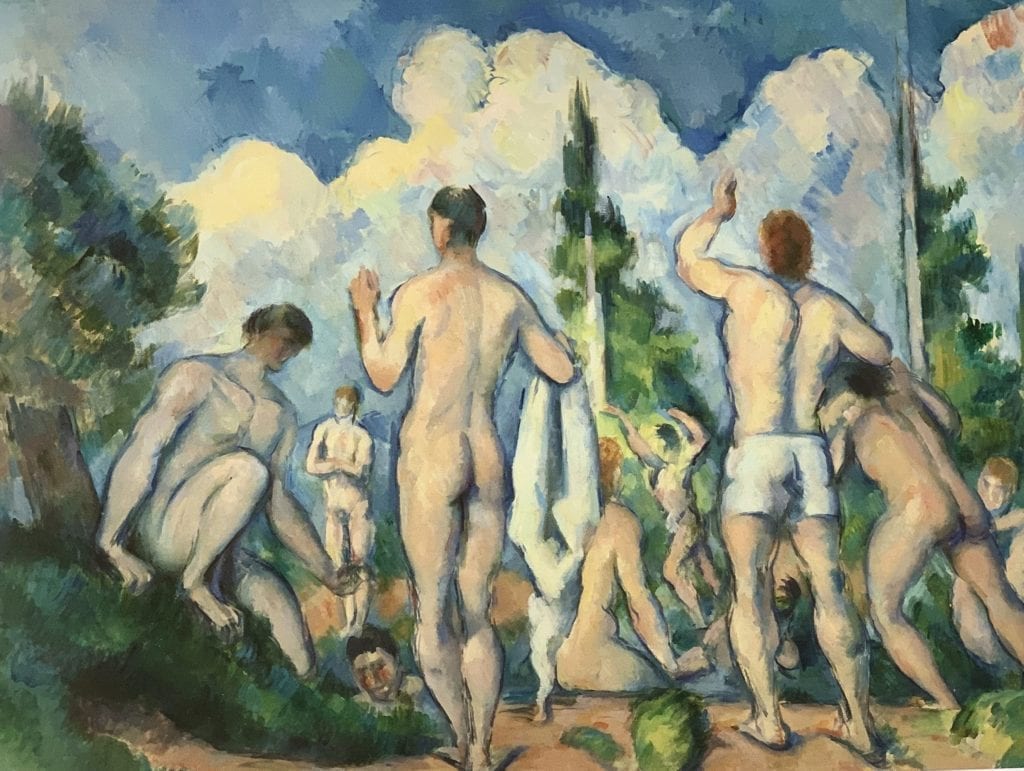Obsessed with nostalgia, Cézanne painted Bathers from memory. It’s one of his many works that dance between reality and invention. Cézanne creates a tension here that reveres the very past it can’t quite enumerate. His later work, such as this masterpiece, merged human figures with natural landscapes. Human bodies don’t move in unison with their surroundings. But Cézanne blended these forms with a majesty of light and color.
Click below for the podcast version of this piece.
Cézanne called himself “student of Pissaro”, a celebrated Impressionist. But his figures feel solid. This painter’s light doesn’t flicker. It shines straight. Cézanne’s paintings have a Post-Impressionist structure and stability. Still, there’s mystery in his pieces. His themes play between actuality and illusion. Bathers takes away as much as it gives the viewer. We see this delicious memory of boys sharing a dip in cool water. But Cézanne also shields them from view. He keeps their backs to us to remind the viewer that memory fades. This one in particular stays hidden. It’s not our memory after all. So, even as he lets us in on his fond boyhood experience, Cézanne keeps us at bay.
The painter excludes us in the same way he’s kept from reliving this fond memory from his youth. That’s why this masterpiece is about memory and nostalgia. They pull at us. This painting draws viewers in with the same teasing beauty. It’s a charming experience as beloved parts of our past seem to be. Yet there’s no way to get inside it. Memories waft away in ephemeral fizzles. Bathers also prevent us from a clear view of their good time. We get hints, gestures, and bare buttocks at best. These feel far away because Cézanne buries much of the figures in clouds and trees.
Bathers Blend into Background
Though the French painter obscures details, the sumptuous feels he shares with us make up for it. We know how much Paul Cézanne loved his waterside frolics as a boy thanks to this painting. The joy reverberates from their bodies in luscious color and shape. Particular bits aren’t necessary. We get it. That’s the glory in this piece. Boys seem to become one with trees and clouds. They’re communal with nature. So this isn’t about the community of Bathers. Rather, it’s about being a part of the greater world. After all, these friends will disperse. We lose touch with each other. But nature remains.
Cézanne shows this deep and lasting connection with the melding shapes of boys and setting. Those who are bathing seem to disappear within the water. Others blend into the trees. While clouds also envelop boys and match them in tonal greys and blues. In fact the only article of clothing, a lonely pair of swim trunks matches the clouds exactly. There’s even a brush of peach in the clouds at our top right. It’s a perfect duplicate to the coral color of buttocks and backs on boys below.
Illusion and reality come together in Bathers. He conveys feelings with masterful ease. The piece blends together the physical world with emotions. There’s also unity between figures and their surrounding world. This singularity reminds the viewer of a profound oneness. The painting’s about more than that captured moment and the memory it represents. It’s about feeling at one with something bigger than ourselves. For some this sense comes with nostalgia. Others find the feeling in nature. I get it from this masterpiece.
Bathers – FAQs
Where can I see Paul Cézanne’s painting Bathers in person?
There are several versions of Bathers by Paul Cézanne. This one’s in Paris at the Musée d’Orsay. Other versions grace the world’s best museums. These include the Metropolitan Museum of Art in NYC, Philadelphia Museum of Art, and the National Gallery in Britain. Cézanne’s associated drawings can be seen at the Museum of Modern Art in New York City as well as Tate Britain.
How does Bathers the painting fit into Paul Cézanne’s body of work?
Bathers exemplifies Cézanne as a Post-Impressionist master. Although another of his bathers works was his largest, The Large Bathers, it’s also an anxious and formal painting. Cézanne wasn’t comfortable painting women nude. So, The Large Bathers sports a self-conscious composition. The women are constrained by a tight triangle. Meanwhile the male forms are more natural. Bathers, with all male subjects, conveys a pleasant scene with ease. Artist, subjects, and viewers can relax and delight in the moment it shares.
Why are there so many versions of Bathers, the painting by Paul Cézanne?
The artist Cézanne painted hundreds of Bathers over his career. This particular work relates to a preparatory piece of the same name. It came right after between 1890–92. It’s also associated with another study dated about seven years later 1899–1900. The French painter loved this method. He produced many studies all of the same subject, gradually refining his compositions. This means he would paint hundreds of versions. The goal? Cézanne sought one work that encompassed the summation of them all.
Why is Post-Impressionist painter Paul Cézanne important in art history?
Many call Paul Cézanne the Father of Modern Art. That includes the artistic masters Matisse and Picasso. He achieved this acclaimed status because his career bridged the 19th and 20th centuries. This can be seen clearly in his master works. Many aspects of his paintings point to Impressionism. But we can also see early aspects of modernist Cubism in Cézanne’s unique paintings. His work has a look all its own. He used repetitive, exploratory brushstrokes that make his paintings easily recognizable.
ENJOYED THIS Bathers ANALYSIS?
Check out these other essays on French Painters.
